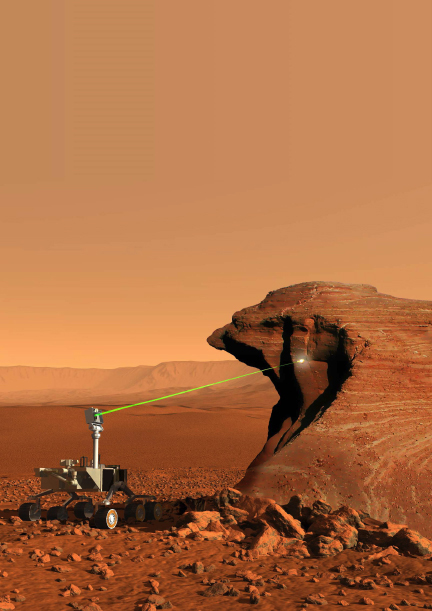Chemistry AND Camera (ChemCam)
Chemistry and Camera complex (ChemCam) is a suite of remote sensing instruments on Mars for the Curiosity rover. As the name implies, ChemCam is actually two different instruments combined as one: a laser-induced breakdown spectroscopy (LIBS) and a Remote Micro-Imager (RMI) telescope. The purpose of the LIBS instrument is to provide elemental compositions of rock and soil, while the RMI will give ChemCam scientists high-resolution images of the sampling areas of the rocks and soil that LIBS targets
looking at rocks and soils from a distance, ChemCam fires a laser and analyzes the elemental composition of vaporized materials from areas smaller than 0.04 inch (1 millimeter) on the surface of Martian rocks and soils. An onboard spectrograph provides unprecedented detail about minerals and microstructures in rocks by measuring the composition of the resulting plasma -- an extremely hot gas made of free-floating ions and electrons.
ChemCam also uses the laser to clear away dust from Martian rocks and a remote camera to acquire extremely detailed images. The camera can resolve features 5 to 10 times smaller than those visible with cameras on NASA's two Mars Exploration Rovers that began exploring the red planet in January 2004. In the event the Mars Science Laboratory rover can't reach a rock or outcrop of interest, ChemCam has the capability to analyze it from a distance
The ChemCam instrument package consists of two remote sensing instruments: the first planetary science Laser-Induced Breakdown Spectrometer (LIBS) and a Remote Micro-Imager (RMI). The LIBS provides elemental compositions, while the RMI places the LIBS analyses in their geomorphologic context. Both instruments will help determine which rock and soil targets within the vicinity of the rover are of sufficient interest to use the contact and analytical laboratory instruments for further characterization. ChemCam also can analyze a much larger number of samples that can be studied with the contact and analytical laboratory instruments. For example, the ChemCam team anticipates making daily analyses of the soil at the rover location to understand variations within the soils both locally and regionally. Furthermore, it can provide valuable analyses of samples that are inaccessible to other instruments, such as vertical outcrops where LIBS can target individual strata using its submillimeter beam diameter. ChemCam has the capability but is not required, to provide passive spectroscopy data of rocks and soils on Mars. The spectral range covered by LIBS is not typical of passive spectroscopy instruments, making it more difficult to know what information can be useful from the spectra.


Leave a comment